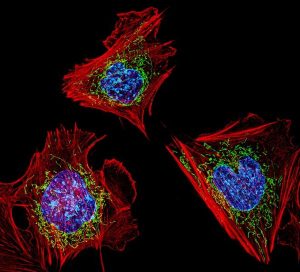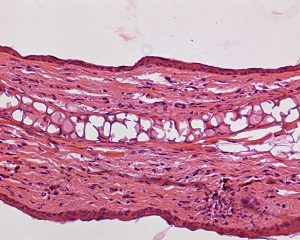Genomic Functions

The main characteristic of nuclear receptors is their capacity to interact with DNA and with proteins that regulate gene expression. Thus, it is only normal that, for quite some time, their study was mainly focused on their genomic function.
As we have mentioned in previous sections, nuclear receptors regulate the expression of different genes and, through this function, they determine cellular response to different simuli.
[clear]
Non-genomic Functions
 However, the actions of nuclear receptors are not limited to the genomic field; they are not mere On and Off switches of the reading of other genes.
However, the actions of nuclear receptors are not limited to the genomic field; they are not mere On and Off switches of the reading of other genes.
Nuclear receptors can interact with proteins from other signaling pathways, modulating their behavior and, therefore, altering the signaling pathway itself. For example, some receptors affect the MAP Kinase signaling pathway. These kinases activate, among others, the AP-1 transcription factor.
Some nuclear receptors (for example, GR) attenuate AP-1 transcriptional activity on specific genes, while others seem to increase it on specific genes (such as ER on the collagenase gene).
Two-way Conversation
Hold on, hold on. In the post-translational modifications section, we saw that MAPKs are capable of phosphorylizing nuclear receptors, altering their function. But now we see that nuclear receptors themselves can modulate the function of MAPKs. The complexity of cellular pathways never ceases to amaze us.
Inflammation and Anti-inflammation

The interaction of nuclear receptors with other pathways has been studied in depth in the case of inflammation.
For example, AP-1 is regarded as a pro-inflammatory factor, while GR is regarded as clearly anti-inflammatory (since there are many anti-inflammatory active substances that act upon this receptor).
NF-κB is another distinctly pro-inflammatory transcription factor. The interference of different nuclear receptors with this factor has been proven. Thus, both GR and PPARγ act as antagonists of the NF-κB pathway.
[clear]
The Ubiquity of Receptors
To sum things up, nuclear receptors form a superfamily of receptors that recognize different ligands and are capable of specifically regulating the expression of a wide variety of genes. Moreover, their ability to interact with other pathways further widens their effects on cell functioning.
Nurcamein: Metabolism, Inflammation, and Cancer
Due to all the reasons stated above, the importance of these proteins in multiple processes is obvious. As the study of these receptors advances, the evidence that its members partake in virtually all physiological processes grows. Their biomedical and clinical importance keeps growing.
The groups in the NuRCaMeIn network focus their research on the role these receptors play in metabolism, inflammation, and carcinogenic processes: three processes with a clear social impact.

Images: Arend, NIH, Roadnottaken, sferrebenedicto
[one_half first]
[icon style=”default” size=”20″]fa-chevron-left[/icon] Classification of Nuclear Receptors
[/one_half]
[one_half]
[/one_half]